
African Americans in Oklahoma Before 1954
Authors
Ralph Ellison
One of the most influential authors of the twentieth century, Ralph Ellison was born in Oklahoma City in 1913. His father, a lover of literature, named Ellison in honor of Ralph Waldo Emerson. Ellison attended Douglass High School, then under the leadership of Inman Page, and received music lessons from Zelia N. Breaux. Training as a musician resulted in his acceptance to Tuskegee Institute to study music in 1933. Ellison found it difficult to fit in with the culture at Tuskegee. He traveled to New York one summer to earn money for tuition and never returned to the university. Rapidly embracing the rich culture of the Harlem Renaissance, he befriended Langston Hughes and began working for the New York Federal Writers Program. This served as a launching pad for his writing career. He began publishing short pieces for a wide variety of publications. During World War II, he served in the US Merchant Marine and returned to New York at the war’s conclusion. He began writing Invisible Man, his most important work, and published it in 1952 to critical acclaim and impressive sales. He was honored with the dedication of the Ralph Ellison Library in Oklahoma City in 1975. Ellison died in 1994.
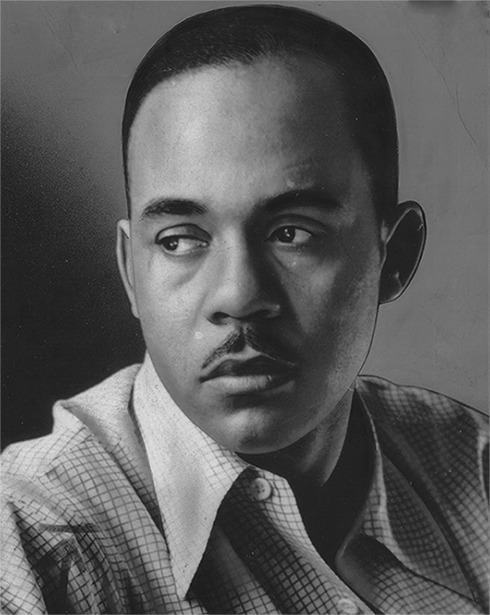
Ralph Ellison, author of The Invisible Man, was born in Oklahoma City in 1913 (21231.465, Bob Burke Collection, OHS).

The Ralph Ellison Library in Oklahoma City (image courtesy The Oklahoman).
John Hope Franklin
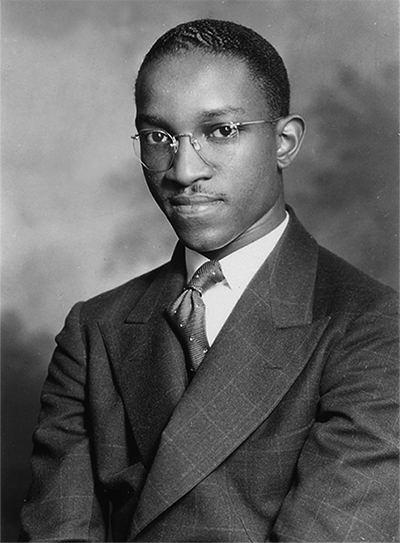
John Hope Franklin (image courtesy The New York Review).
John Hope Franklin was born in Rentiesville, an All-Black town, in 1915. His father, Buck Colbert (B. C.) Franklin, was a prominent attorney who used his knowledge of the law to protect the integrity of Black Wall Street and the property rights of its citizens in the aftermath of the Tulsa Race Massacre. The elder Franklin took an 11-year-old John Hope Franklin to attend a lecture by renowned Black scholar W. E. B. DuBois. In subsequent decades, they would become close friends and allies. He attended Booker T. Washington High School in Tulsa, but was denied admission to the all-white University of Oklahoma, and elected to attend Fisk University in Nashville, Tennessee. He earned a bachelor’s degree in 1935. From there, he transferred to Harvard where he earned both a master’s and PhD in history.
In 1947, he wrote From Slavery to Freedom: A History of American Negroes. This groundbreaking history sold millions of copies, and updated editions are still printed today. In the early 1950s, he assisted the NAACP Legal Defense team arguing Brown v. Board of Education with research demonstrating the harms of segregation. In 1956, he became the first African American department chairman at the primarily white Brooklyn College.
This was one of many firsts, such as the becoming the first Black president of several historical associations, including the American Historical Association, the Southern Historical Association, and Phi Beta Kappa. In 1995 Franklin was awarded the nation’s highest civilian honor, the Presidential Medal of Freedom.
John Hope Franklin died in 2009 at the age of 94, after decades of teaching, scholarship, and advocacy. In 2018, the John Hope Franklin Reconciliation Park was dedicated in Tulsa in his honor.
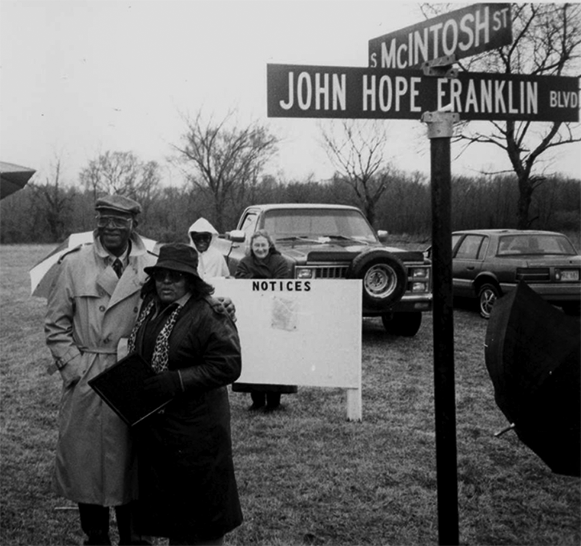
John Hope Franklin, pictured at the street honoring him in his birthplace of Rentiesville, Oklahoma (21446.TO.M184.51.1.12, Larry O’Dell Collection, OHS).
Musicians
It is no coincidence that Oklahoma produced several important musicians during the first half of the twentieth century. A strong tradition of playing instruments existed in many families, and there was access to instruments and skilled musicians to instruct. The importance of musical performance by community members in churches, picnics, and dances provided a strong incentive to learn to play. Local segregated school districts, such as Oklahoma Public Schools, hired Black educators to manage different disciplines in the schools for African Americans. Visionary educators such as Zelia Breaux constructed musical education offerings that were unmatched elsewhere and created a reputation of exceptional skill for those who went through those programs. The vibrant all-Black entertainment establishments in neighborhoods like Deep Deuce offered serious musicians the opportunity to practice their craft while earning money and a chance to work with internationally-known musicians who performed there.
Charlie Christian
In the world of American popular music, Charlie Christian made a major impact. Originally from Texas, Christian’s family moved to Oklahoma City when Christian was two. He was from a musical family, and learned the trumpet as a child and the guitar upon the death of his father. Music flowed in the African American neighborhood of Deep Deuce in Oklahoma City in the 1920s and 1930s, and Christian spent time there practicing and learning. In 1937, Christian took up the electric guitar. His debut on the electric guitar made quite a splash within the local music scene. It was not long before music promoter John Hammond began finding opportunities for Christian beyond Deep Deuce. Christian began touring with Benny Goodman. Charlie Christian died of tuberculosis in 1942, at the age of 25 He only played professionally for a handful of years but his contribution to music—taking the guitar from a background rhythm instrument to a featured soloing instrument—laid the foundation for how American musicians approached the guitar for generations to come.
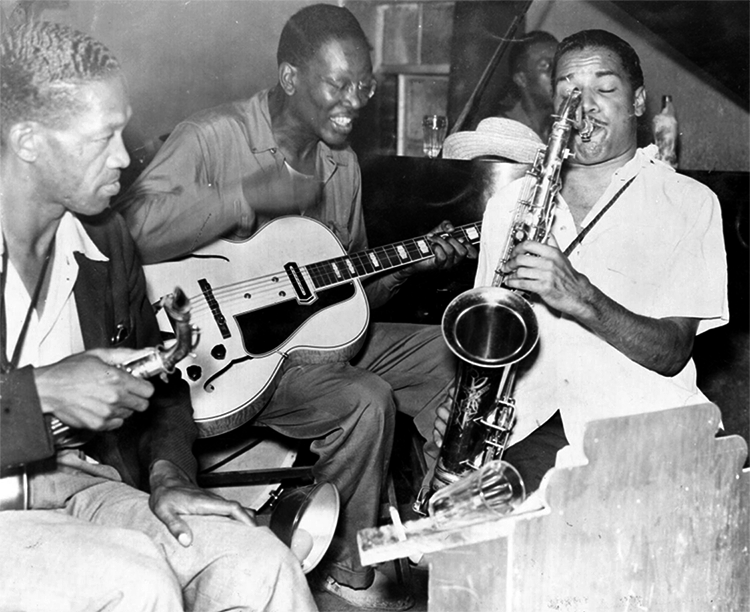
Charlie Christian, middle, with Leslie Sheffield, left, and Dick Wilson, right (20699.84.92.16, Frank Driggs Collection, OHS).
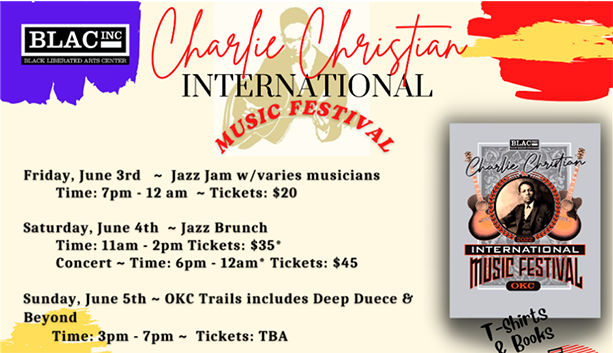
Every year, the Black Liberated Arts Center, Inc. (BLAC, Inc.) in Oklahoma City hosts a Charlie Christian International Music Festival (image courtesy BLAC, Inc.).
Lowell Fulson
Born in Tulsa in 1921, Lowell Fulson (Choctaw) grew up with a musical family. He picked up the guitar as a child and played in church. He served in the military for two years and then relocated to Oakland, California, where his music career took off. He recorded several hits in the late 1940s when Rhythm and Blues was developing into its own genre. Fulson wrote several hits, including “3 O’Clock Blues,” ’Reconsider Baby,” and “Tramp.” His accolades include induction into the Rock and Roll Hall of Fame and the Blues Foundation Hall of Fame. He died in 1999.
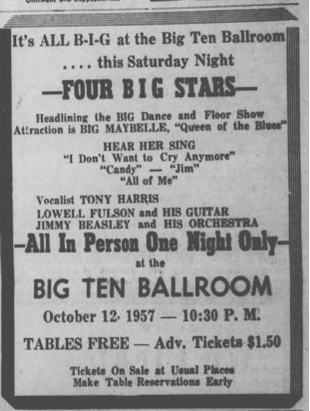
Advertisement for a Fulson performance, The Oklahoma Eagle, October 10, 1957.
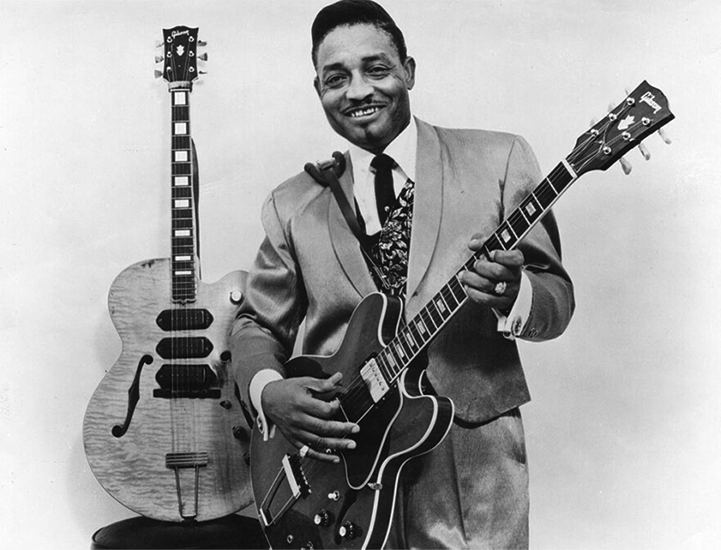
Lowell Fulson (image courtesy KOSU)
Jimmy Rushing
Born in Oklahoma City in 1901, Jimmy Rushing’s father played tuba for local bands. Rushing picked up music easily, including the piano, which his parents expressly forbid him from learning. Rushing attended Douglass High School, which had an unmatched music department led by Zelia N. Breaux. Rushing continued his musical study at Wilberforce University. After school, he began performing with lesser-known bands. In 1935, Rushing joined the Count Basie Orchestra where he remained as a vocalist for 13 years. His success continued when he formed his own band. Fellow Oklahoman Ralph Ellison was a fan of Rushing. He received numerous vocalist awards throughout his career. Rushing died in 1972, and was honored by the US Postal Service with a stamp featuring his image in 1994.
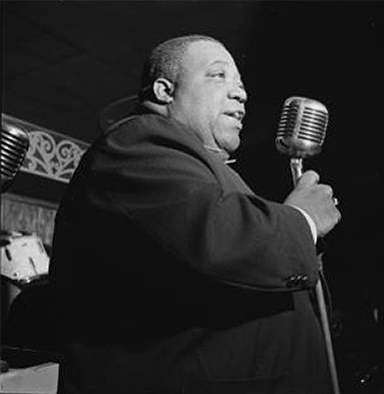
Jimmy Rushing performing; photo by William Gottlieb (image courtesy the Library of Congress).
Roy Milton
Roy Milton was born in Wynnewood in 1907 and moved to Tulsa before joining Ernie Fields’s band as a vocalist in the 1920s. Later, he began playing the drums for Fields as well. In 1933, Milton decided to break with Fields and start his own band. He moved to Los Angeles and formed the Solid Senders. Frequently on tour, they did stop to record Milton’s first major hit, “R.M. Blues.” A core artist on the Specialty record label, the Solid Senders had nineteen Top Ten R&B singles. Milton died in 1983.
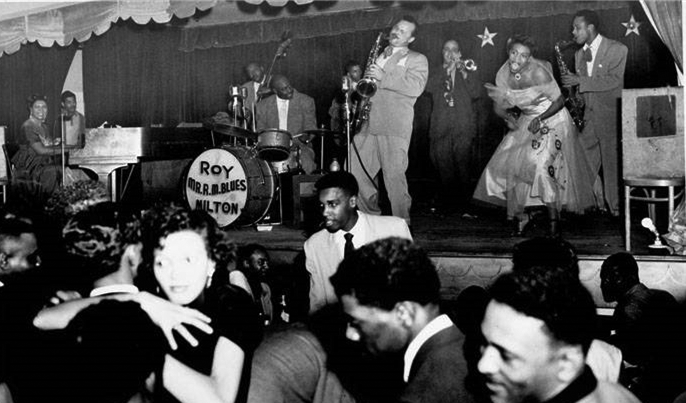
Roy Milton and the Solid Senders in San Antonio, c. 1950s (image courtesy UTSA Special Collections).
Don Byas
Born in Muskogee in 1912, Don Byas came from a musical family. As a child, he received musical instruction in violin, clarinet, and saxophone. He played with local swing bands as a teenager and formed his own group when he attended Langston. After school, he moved to New York, where he played saxophone with a variety of groups and performed at the Cotton Club. He played with the biggest names in jazz, including Billie Holiday, Charlie Christian, and Thelonious Monk. In 1941, he began performing with Count Basie. During that time, the Count Basie Orchestra was featured in two films and Byas had a role in both. He left Count Basie in 1943, and his interest shifted to an emerging type of jazz called bop. He joined smaller groups that included more experimental artists, such as Charlie Parker and Max Roach. After World War II, Byas moved to Europe, and did not return to the US until 1970. He died in 1972, and was inducted into the Oklahoma Jazz Hall of Fame in 1997.
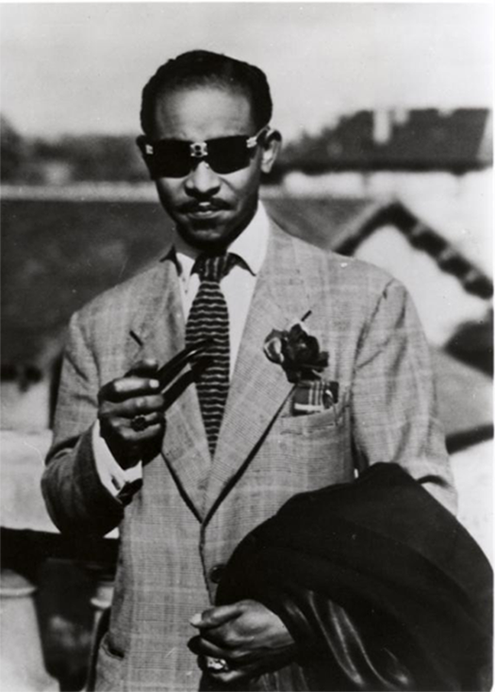
Don Byas (image courtesy University of Missouri—Kansas City).

